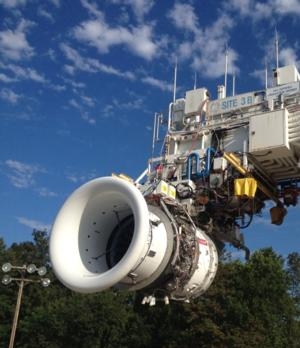Tue, Sep 10, 2013
Achieved Full Take-Off Thrust In The First Of A Comprehensive 60-Engine Test Program
CFM International has initiated testing of the first full LEAP engine, launching an extensive ground and flight test certification program that will encompass 60 engine builds over the next three years. The program will culminate in engine certification in 2015 and first entry into commercial service on the Airbus A320neo in 2016.

The LEAP-1A engine, which is the powerplant for the Airbus A320neo, fired for the first time on September 4th, two days ahead of the schedule. After a series of break-in runs, the engine was operating smoothly and has reached full take-off thrust. “In the past five years, we have completed thousands of hours of component testing leading up to this day,” said Chaker Chahrour, executive vice president of CFM International. “Everything we have seen tells us the LEAP engine is going to deliver all we promised, and much more. Now, we get to put it through its paces in the most comprehensive test program we have ever undertaken. By the time this engine enters services, we will have simulated more than 15 years of airline service with 60 different engine builds.”
The engine, which shares common turbomachinery with the LEAP-1C, is installed at Site 3B at GE’s Peebles, Ohio, outdoor test facility, where it will be on test for the next several weeks. The overall certification program, which encompasses all three LEAP engine variants, includes 28 ground and CFM flight test engines, along with a total of 32 flight test engines for Airbus, Boeing, and COMAC. Over the next three years, these engines will accumulate approximately 40,000 hours (18,000 engine cycles) leading up to entry into service.
“This is an exciting day for us,” said Cédric Goubet, executive vice president for CFM. “We are very proud of the fact that we have had 21 entries into service in our history; each of them was as on time and met all the specifications. From everything we have seen so far, the LEAP program is going to maintain that record.
”We believe we have the best team in aviation. Today, we thank each member for their tireless dedication to this project and congratulate them for the phenomenal job they have done in keeping this program on schedule. In fact, the first engine to test was actually two days ahead of the planned target to fire date we set nearly three years ago.”
(Image provided by CFM Engines)
More News
Aero Linx: Model Aeronautical Association of Australia MAAA clubs are about fun flying, camaraderie and community. For over 75 years, the MAAA has been Australia’s largest fl>[...]
Touchdown Zone Lighting Two rows of transverse light bars located symmetrically about the runway centerline normally at 100 foot intervals. The basic system extends 3,000 feet alon>[...]
“Discovery and innovation are central to our mission at Virgin Galactic. We’re excited to build on our successful record of facilitating scientific experiments in subor>[...]
How To Get A Story On Aero-TV News/Feature Programming How do I submit a story idea or lead to Aero-TV? If you would like to submit a story idea or lead, please contact Jim Campbel>[...]
Student Pilot Reported That During Rotation, “All Of A Sudden The Back Of The Plane Kicked To The Right..." Analysis: The student pilot reported that during rotation, “>[...]
 ANN's Daily Aero-Linx (05.02.24)
ANN's Daily Aero-Linx (05.02.24) ANN's Daily Aero-Term (05.02.24): Touchdown Zone Lighting
ANN's Daily Aero-Term (05.02.24): Touchdown Zone Lighting Aero-News: Quote of the Day (05.02.24)
Aero-News: Quote of the Day (05.02.24) ANN FAQ: Contributing To Aero-TV
ANN FAQ: Contributing To Aero-TV NTSB Final Report: Cirrus Design Corp SR20
NTSB Final Report: Cirrus Design Corp SR20



